| Home | Material | My Telescopes | Mirror Making | Deep Sky | ext. Links |
| 32" Mirror | 24" Kyklopas | 17,5" Aristarchos | 14" Mirror | 10" Archimedes | 10" Travel Dobson | 24 cm Quints | 17 cm Twins | 6" Traveldobson |
| Deutsch (de)![]()
| Home | Material | My Telescopes | Mirror Making | Deep Sky | ext. Links |
| 32" Mirror | 24" Kyklopas | 17,5" Aristarchos | 14" Mirror | 10" Archimedes | 10" Travel Dobson | 24 cm Quints | 17 cm Twins | 6" Traveldobson |
600 mm f/3,3 Meniscus Mirror

Advantages of the same overall thickness: Enhanced stiffness at same weight. More uniform cooling of middle and edge.
Disadvantage: Much more effort, to grind the back side and support the mirror during grinding and polishing
See intruduction in Cloudy Nights and in the German forum Astrotreff here and here
|
The meniscus was milled out of the full material, as slumping (heating and bending to shape in the oven) was no accessible option to me. Generating the concave front side with a grinding machine on a jig out of 600x34,5 mm Supremax blanks |
|
|
Generating the convex back side. Grinding over the edge produces chips in the glass |
|
|
Protective mask, ear protection and a strong fan, that blows the dust away from the body |
|
|
Fitting the concave frontside on the convex backside to grind out the residuals from the rough machine generating. Diameter: 600 mm |
|
|
Grinding with #180 with the 40 cm granite tool. A 610x40 mm mirror with the same but concave radius is used, to support the convex back side of the menicus mirror. |
|
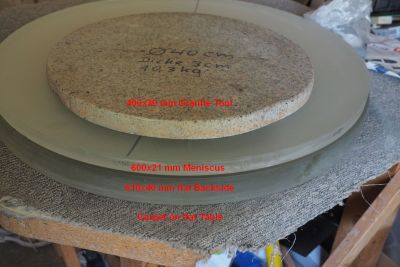 |
Grinding with #320 and Microgrit 25 my with the 40 cm granite tool. The meniscus mirror is frequently rotated against the "support mirror". |
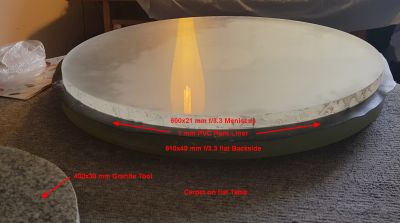 |
From Microgrit 15 my on I put a 1 mm PVC pont liner between meniscus mirror and support mirror. The finer the grits, the more often I rotated the upper mirror against the lower one, to minimize potential astigmatism. I continued with Mictrogrit 9 my, 5 my and ended fine grinding with 3 my.
The image shows the ground out mirror after 3 my grit. It beginns to shine at gracing angles already. |
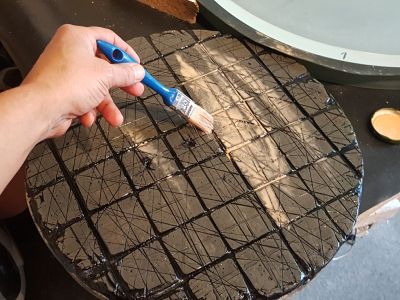 |
Polishing:
The pitchlap on the 40 cm granite tool. The channels were pressed with an aluminum rail into the warm pitch by rinsing hot water over the pitchlap, pressing the channels into the pitch and laying the pitchlap onto the mirror. I repeated this course until I had even channels and full contact to the mirror surface. See the procedure here in more detail. Additionally I cut micro channels with a knife into the warm lap for improved fit and enhanced polishing action. The pitchlap suck onto the glass causing strong resistance against moving it. Polishing replaces the the fitness studio: Video polishing with 40 cm Tool (18MB) After barely 20 minutes of polishing there appeared a uniform shine all over up to the very edge and after 7-8 exhausting hours (see heartbeat courve) of net polishing time the mirror was polished out completely. |
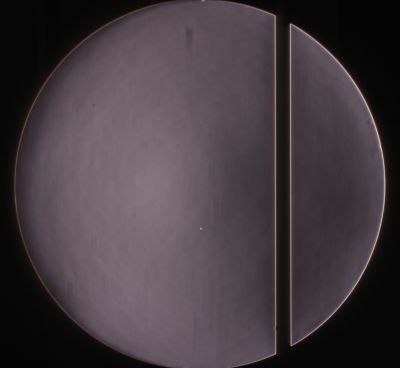 |
Foucault test of the polished out mirror (slit less tester with knife from the left): Almost spherical with shy depression towards the center (CC= -0,02), smooth and zone free surface. The ruler test shows a good edge. The inhomogeneities on the picture are due to air turbulences and Foucault artefacts. |
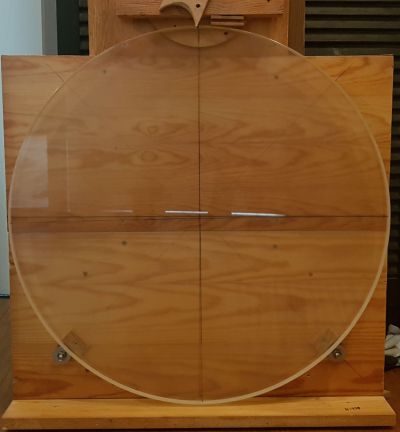 |
The mirror on the test stand with 2 lateral supports in 2x45° orientation. The edge supports are made of large washers, that are placed exactly under the center of gravity, which is in this case 5 mm from the back edge. This way the mirror hovers on the supports almost free of axial forces from the back or from the front side. |
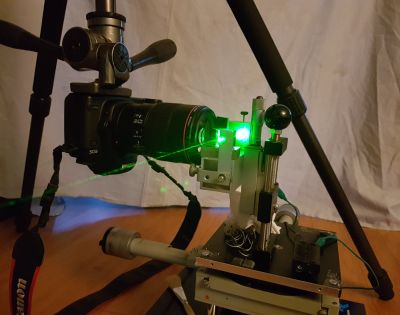 |
The nice and highly functional Bath interferometer in 45° arrangement build by Alois and Alfredo. It showed almost no astigmatism on the mirror. The overall astig due to the mirror sagging in the test stand is obvious, but stays the same, when the mirror is rotated. |
Home | Imprint | Privacy Policy | about |